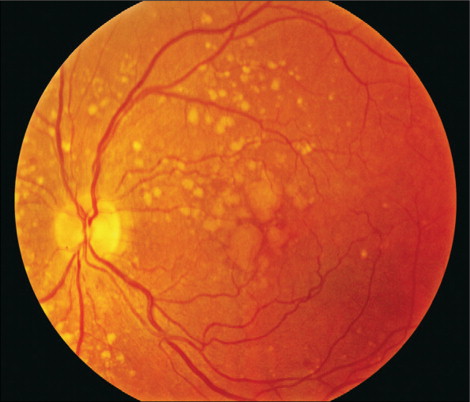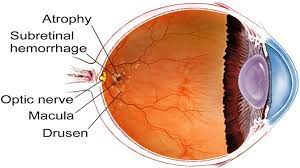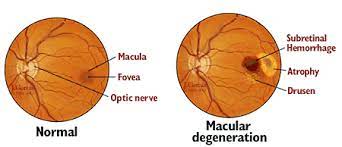Age Related Macular Degeneration
Age-Related Macular Degeneration (AMD) is a prevalent eye condition that primarily affects individuals aged 50 and older. It is characterized by the deterioration of the macula, the central part of the retina responsible for sharp, central vision. AMD is a progressive condition and can lead to significant vision loss if not managed effectively.
Understanding AMD is crucial because it can impact your daily life in various ways. Tasks like reading, driving, and recognizing faces become challenging as central vision blurs or distorts. However, there's hope. By adopting specific lifestyle changes and engaging in recommended exercises, you can potentially slow down the progression of AMD and improve your overall eye health.
Symptoms
One of the hallmark symptoms of AMD is the gradual loss of sharp, central vision. This can make it difficult to recognize faces, read, drive, or perform tasks that require clear central vision.
Distorted VisionAMD can cause straight lines to appear wavy or bent. This distortion in vision can make it challenging to see details accurately.
Dark or Blank SpotsPeople with AMD may experience dark or blank spots in their central vision. These blind spots can interfere with everyday activities like reading and recognizing faces.
Difficulty in Low-Light ConditionsAMD often leads to reduced night vision and difficulty seeing in dimly lit environments. Activities like driving at night may become challenging.
Color Perception ChangesSome individuals with AMD notice changes in their ability to perceive colors accurately. Colors may appear less vibrant or distorted.


Do's & Dont's
Do's
Regular Eye ExamsMake it a priority to schedule routine eye exams with an ophthalmologist or optometrist. These professionals can detect AMD in its early stages, allowing for prompt treatment.
Quit SmokingIf you're a smoker, consider quitting. Smoking is a significant risk factor for AMD. By quitting, you can reduce the rate at which the disease progresses.
Healthy DietA diet rich in antioxidants, vitamins (particularly A, C, and E), and minerals like zinc and copper can support your eye health. Leafy greens, colorful fruits, fish, and nuts are excellent choices.
Protect Your EyesInvest in sunglasses that offer adequate UV protection. Prolonged exposure to harmful UV rays can contribute to AMD development. Wearing sunglasses when outdoors is a simple yet effective preventive measure.
Manage Blood Pressure and CholesterolHigh blood pressure and elevated cholesterol levels can accelerate AMD progression. Monitoring and managing these factors through diet, exercise, and medications can help preserve your vision.
Dont's
Don't SmokeSmoking is a leading modifiable risk factor for AMD. The chemicals in tobacco can damage the blood vessels in your eyes and exacerbate the condition.
Avoid Excessive UV ExposureProtecting your eyes from excessive sunlight is crucial. Overexposure to UV rays can lead to oxidative stress in the eyes, contributing to AMD.
Limit Processed FoodsProcessed foods often contain unhealthy fats and additives that can negatively affect your eye health. Opt for whole, natural foods whenever possible.
Avoid High-Fat DietsDiets high in saturated and trans fats can increase inflammation and oxidative stress, potentially accelerating AMD progression. Opt for a balanced diet low in unhealthy fats.
Don't Ignore SymptomsIf you notice any changes in your vision, such as blurriness, distortion, or dark spots in your central vision, it's essential to consult your eye specialist promptly. Early detection and intervention can make a significant difference in managing AMD.
Exercises
Regular eye exercises can help maintain the strength of your eye muscles and improve blood flow to the eyes, potentially slowing down AMD progression. Here's a breakdown of the exercises:
Sit comfortably and slowly roll your eyes in a clockwise direction for 10 seconds, then counterclockwise for another 10 seconds. Repeat this exercise a few times. This exercise helps maintain flexibility in your eye muscles.
Focus ShiftingTo enhance your ability to focus, practice shifting your gaze from an object up close to an object in the distance. Do this around ten times. This exercise helps your eyes adapt to varying distances.
PalmingTo relieve eye strain, rub your hands together to generate warmth and then gently cup your palms over your closed eyes. Hold this position for 10-15 seconds, repeating as needed. Palming can help relax your eye muscles and alleviate discomfort.
BlinkingBlinking rapidly for 30 seconds helps moisturize your eyes and reduce dryness. It's particularly useful if you spend a lot of time in front of screens, where you might blink less frequently.

Summary
Age-Related Macular Degeneration is a condition that demands proactive management for a brighter future. By adhering to the do's and don'ts outlined above, you can reduce your risk of AMD progression and maintain your quality of life. Incorporating these simple eye exercises into your daily routine can further support your eye muscles and circulation. However, always remember that regular check-ups with your eye specialist are essential for early detection and treatment. By taking these steps, you can regain control of your eye health and look forward to a brighter future despite living with AMD.